Devin Devine, masonry and landscaping contractor
Types of retaining wall–this article will start out with the cheapest types of retaining wall, and end up with superior types, which may take longer and/or cost more. I searched the internet for similar articles, and found many that seemed to be written by people with little to no first hand experience building retaining walls. As such, I thought it’d be a good idea to share some of my thoughts, on the best/worst types of retaining wall out there. This article is meant to be helpful, but not comprehensive–just me, sharing some insights about various wall types. If you need clarification on any point, feel free to ask in the comments below, or set up a DIY consultation, if you have extensive questions.
TL;DR = just build a dry stone wall
Cheapest, fastest and fastest retaining wall: 6 x 6 pressure treated lumber
AKA railroad ties. Back in the day, actual rail road ties would be used, or tar covered 6 x 6 lumber. This type of wall goes up fast.
Downsides: will not last forever. Might get 10 good years, then another 5 or 10 declining years. Oh, and then there’s the whole toxin thing. Personally, I’d prefer not to grow veggies, in a garden with pressure treated lumber present. I’ve read that the toxins tend to leech out in the first few years, but such information can not be verified at this time. To verify: I’d probably need a bunsun burner, some beakers, a decanter, some distillation apparatus–and some chemistry knowledge.
Upsides: is really really fast to install. I remember being a young guy and employed by some company and they sent me, solo, to build a 6 x6 lumber wall, with steps–and it took me a day. Would have taken a week to build like that with SRW’s–or a month, with Dry Stone.
Tip to make it sturdy: dead men. Set some lengths of 6 x 6 going back into the hill. 3′ long, or so, depending. The more dead-men, the stronger the wall. Attach 6 x 6’s to each other using 9 inch inch nails, like the ones the paver guys use for their plastic edging. Also, anchor the fist course into the ground via rebar.
Even cheaper variation
Do the same type of wall, but using logs. instead. Will get 5 good years before the wood really begins to rot, fast. But then again, this rotting wood is nutrient rich, and retains moisture well–so this is a MUCH better option, for a retaining wall adjacent to, or incorporated into any garden! If larger logs are used and if the wall is shorter, these can be built fast, without any nails or rebar involved.
Gabion walls
Basically a wire cage, filled with rocks. Approximately 10 out of 10 times these things are as ugly as sin, vice, corruption and deceit. We will speak of them no more!
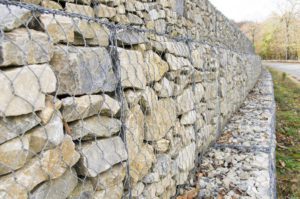
Pardon me a moment, while I go disinfect my eyeballs. Okay, fine, they’re maybe not that bad, and surely have their place.
Pretty much only good for industrial applications.
SRW–segmented retaining wall blocks
Not as fast as railroad ties, but faster than many other types of retaining wall. Can last long, if well-built. Not very beautiful to look at.
You’ll see these sometimes, 20 or 50 feet tall, next to a supermarket, or some place like that. Not good looking–but impressive, in that they can be built fast, and can be sturdy for such a height. Mind you, an engineer is involved, so such a high wall.
SWR walls are built upon a crushed stone foundation. Compact the sub grade, lay gravel, compact that, then screed out 1″ (or less) of bedding sand (or rock dust) to provide yourself with a perfectly level spot on which to set them blocks. Usually you’ll want a weep drain in there, and if taller than a few feet, you’ll want to use a geogrid fabric system, that ties the wall into the soil behind the wall. I was certified to build these, and led crews….back in the late 90’s and early 2000’s. The tech doesn’t seem to have changed much over the past 20 years–although every year the manufacturers of these products come out with catalogs making it sound like the tech has advanced. LOL, look at our new shiny product that’s the exact same as last years!
Good for commercial applications.
Poured concrete
Tends to last awhile….but often with big huge ugly cracks. My predictions–usually you get two or three good years–then some huge terrible crack. The wall will stand for a good 40 years….but will start leaning out, at some point during that span. Not y favorite type of retaining wall, by a long shot. Part of the reason the wall will “stand” (I mean lean…) for so long is because these types of walls are expensive and difficult to remove, once they’ve begun deteriorating.
Tips: you better have a weep drain up on there. Dig below the frost line. Again–not my favorite, aesthetically it’s ugly, it doesn’t last forever and tends to age poorly, isn’t fun (for me, a stone guy) to build, and has a significant environmental impact.
My opinion on the matter–not very relevant to commercial, residential, or industrial applications, any more. Some residential contractors still pour concrete retaining walls, for new home construction. I can hear them cracking now.
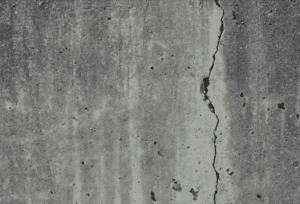
cracks in a concrete wall are usually an aesthetic improvement–until the wall starts leaning outwards, and unevenly.
CMU retaining walls
also known (wrongly) as cinder blocks
Called cinder blocks because back in the day cinders were added to the cement mix when making these blocks–to make them lighter. Now, they get air up on there, to save on weight and material costs.
More on CMU retaining walls? Who cares? They’re not the best! Like with SRW walls and poured concrete walls, weep drains are important here.
Then again, a stuccoed CMU wall, with a stone cap, can look pretty spiffy. For a formal look.
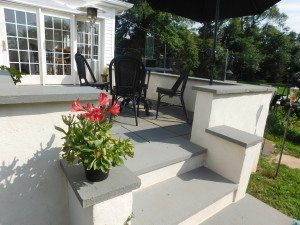
So it’s not actually a retaining wall, is rather a photo of a raised patio we did back in 2014–but it shows you the look of a CMU wall, with bluestone cap. A much more formal look, than I usually go with.
Lick n stick thin stone veneer over CMU wall?
Nope!
Sure, it’s cheaper than a real stone wall–but just so ugly and fake looking. Tacky. A regular CMU wall tends to look less tacky. Save some $$$ and just stucco your cmu wall–if you must build a cmu wall.
Dry stone retaining walls
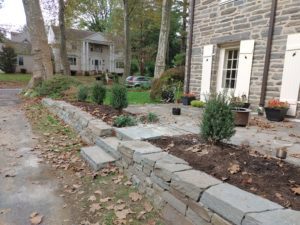
Partially students work (but I helped). I do offer patio and wall building instruction and DIY consultation services.
Oh, you want to build something beautiful that will last generations, if built right, and that will not cause undue environmental impact nor expose your family and pets to toxins?
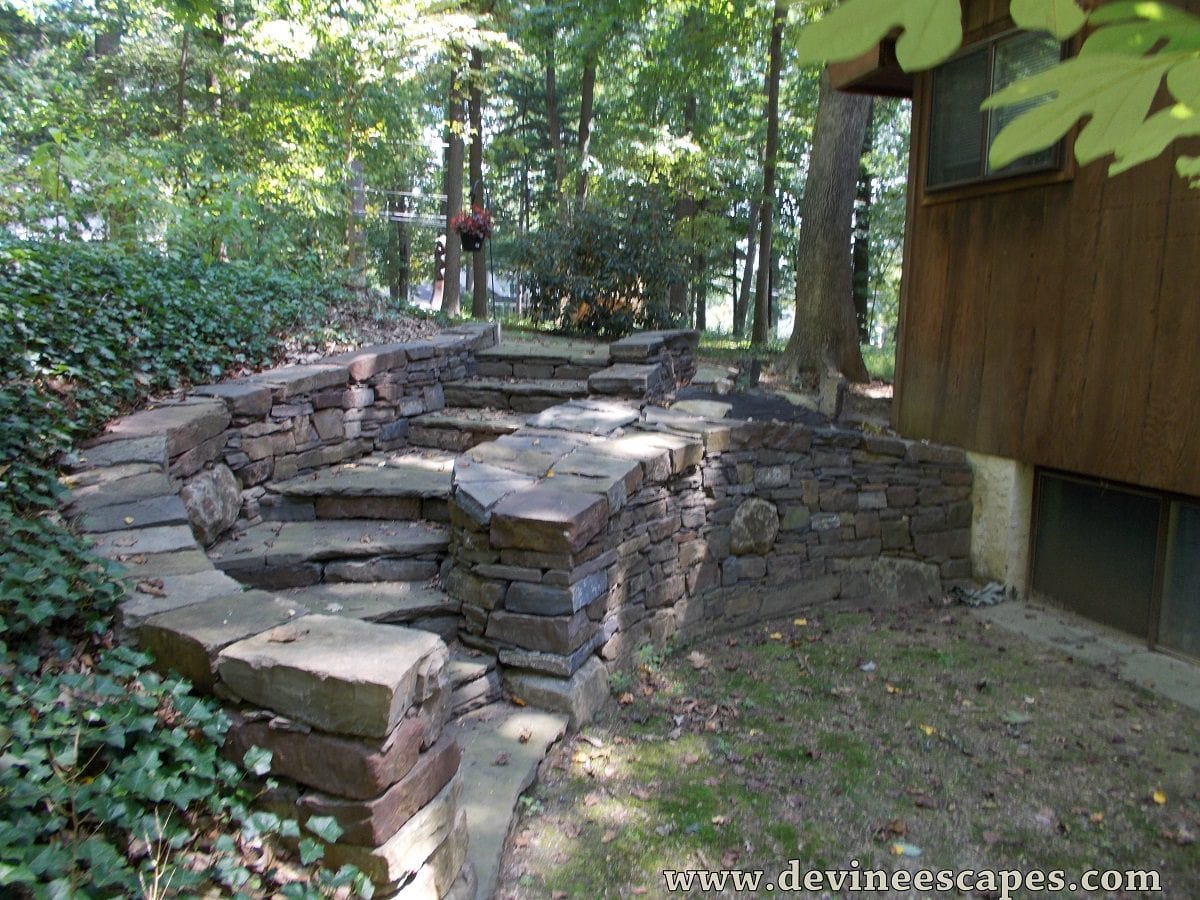
dry stone wall and steps by Devin Devine summer 2010 (photo 2018)
That’s great news and I applaud your decision! This type of wall will take ten times longer than any other type listed here. Still with me? Good!
This sort of wall will take more time, and the material (usually) isn’t super cheap either. But every day, you’ll see this–rather than what you saw at the top of the page. Beauty is good for the eyes, good for the heart. And all the work involved? We call that good exercise, fresh air, and time well spent and when you’re finished it feels good, to see what your hands have wrought. Life is good–turn off the tv and the internet (after reading this article) and know that it is true. The world is a good place.
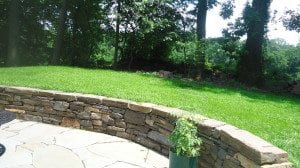
Another retaining wall I built –also in 2010. both this one and the one with the steps were built using free stones, harvested from a construction site. After they excavated and got rid of all the stone–they poured stamped concrete fake stone!
To build a dry stone wall that is beautiful and lasts ages:
- build it double-faced (aka double skinned)
- use plenty of through stones. Yes–they’re like the “dead men” described way up top
- “batter” that wall–do not build it plumb, but have it leaning back into the hillside. That’s called using gravity to your advantage.
- pack your hearting by hand, no gravel pouring for the infill!
- no fabric or gravel needed behind the wall either–this isn’t an SRW!
- Read this article wall–or hire a contractor who has an impressive portfolio of completed projects in dry stone
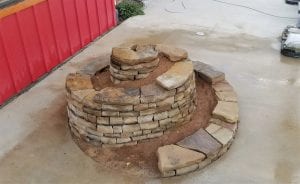
dry stone wall technology can also be used, to create interesting forms, such as this dry stone spiral herb garden, built by myself in 2018
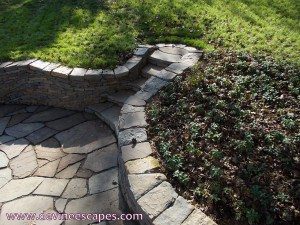
another dry stone retaining wall, with steps

Same wall, detail shot. I forgot to bring my level and string line, that day.
Post Script
Retention wall– huh? Retainer wall–say what? How about a “masonary” “retention wall”? I kid. Of course, regional terms may vary, but sometimes, people just say the thing incorrectly.
Or Dry “stack” stone wall. You mean–as opposed to a mortared “stack” stone wall, or a brick stack wall? Please stop, my belly can’t take it.
Tune in again in just a week or two, because I will have a newly completed dry stone sculpture to showcase.

“This will be the best on yet–you bet!”
Thank You
I am thankful today for a day’s rest. Everything aches, my body, mind, and heart–but I am grateful for these, too! I am deeply grateful for everyone who has helped me, supported and encouraged me on this stone art journey. The adventure continues!